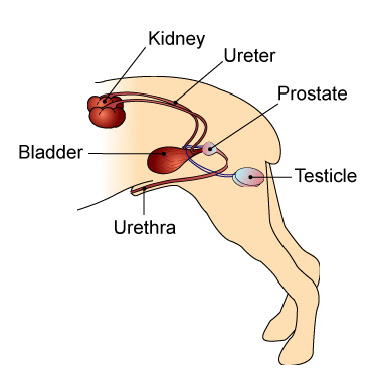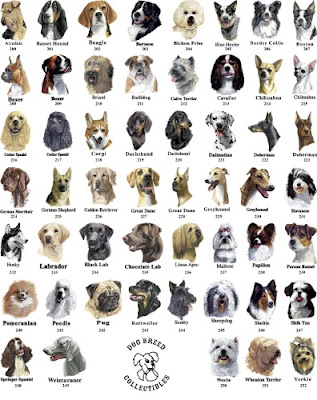Puppy training
House training is very important for the puppy. Vets recommend that house training may begin any time after 5 weeks. The key is to be consistent and be patient. Reward good behaviour with praise, petting and maybe a treat. Puppies demand a lot of attention, and you should reward good behaviour.
Learning ‘’sit’’
 Whenever the puppy wants to be scratched. Respond by holding your hand on the puppy’s nose and say your dog’s name, then ‘’sit’’.
Whenever the puppy wants to be scratched. Respond by holding your hand on the puppy’s nose and say your dog’s name, then ‘’sit’’.By moving your hand back over his ears as you speak, it makes the puppy to look up. Keep repeating ‘’sit’’ until the puppy sits down. After the puppy sits for a few seconds, release him by saying ‘’ok’’.
Then reward the puppy with a pet and praise. It may take few tries. But gradually increase the sitting time. Be sure the others who handle the puppy uses the same commands for the consistent messages to the puppy.
Where to go to the bathroom
You should feed your puppy inside the house. Dogs don’t like to eat where they relieve themselves. If your dog is relieving itself in the certain area, feed him or her on that spot immediately.Then take the puppy outside to its bathroom area. Letting the puppy outside and walking the puppy regularly lets it to know that it can wait and there would be opportunities to go to the bathroom outside. Dogs and puppies learn their routine quickly.
Whenever the puppy relieves itself, reward the puppy with praise. Look right at it, not at the dog. If your dog sniffs it, praise it and pet it. Vets estimate after four days you should expect your puppy automatically head to its correct place. But it may take longer.
Punishing mistakes
Punishing your puppy is important for efficient training. You need to act grunt and act disgusted and tale puppy out of his bathroom area. Leave the puppy there while you are cleaning.Some dogs apparently enjoy their owners clean up and leave another gift to enjoy experience. Accidents should be cleaned up without any odour.
Food and Health care
Feed your puppy’s four meals a day until the age of four months and then reduce its feed to three meals per day until its six months old, when you change to two meals a day and keep this routine to rest of its life. However make sure that water is always available, so never take the water bowl away. There are three types of puppy food. They are:
 Dry complete food
Dry complete food
There are a wide variety of Dry complete foods in the market and the quality varies. Dry complete food
Dry complete foodTo get the best one out for the puppy’s development choose a food specially designed for puppy.
Many are based on chicken and rice or corn, and these types suit the puppies really well.
Semi-moist and tinned food
 Semi-moist and tinned foods can vary in quality. To choose the best quality with the easily digestible recipe. Example recipe:
Semi-moist and tinned foods can vary in quality. To choose the best quality with the easily digestible recipe. Example recipe:Chicken and rice and choose a specialist puppy food which is nutritionally complete. Avoid changes in your puppy’s diet so if you find a product that works for your puppy, stick to it.

Home- made food
Puppies need the best possible diet whilst they are growing up, as even a slight imbalance may harm their development and growth.
As it is very difficult to get this balance right, you are probably better off choosing one of the tried and tested foods.
Vaccinations for your puppy
Why vaccinations are vital?
Vaccinations are vital, if you want your puppy to stay a healthy long life. Puppies and dogs have an instable curiosity and they investigate the world around them. While doing this, it is certain they may come in contact with a vital disease that may harm them or even KILL THEM! To avoid this, scientists have a found a good cure and that is vaccinations.Vaccinations are given so that the dog or puppy becomes immune to that disease. As they are many vital and common diseases throughout the world and UK. In fact where most viruses are concerned there aren’t any treatments available. So if you want your pet to be safe, follow the old saying. Prevention is better than cure. Remember, while you are protecting your own pet through vaccinations. You are also safeguarding your other dogs as well.
Since yours is becoming as non-spreading carrier of diseases with the potential to spread the infection as far as wide. As you can imagine, if more and more dog keepers take their responsibility seriously, we are much better chance of controlling the impact of disease and avoiding problems and worries to go with it.
When to vaccinate your puppy?
 To be effective then, vaccination must be carried out before your puppy loses temporally immunity from the mother. It should certainly begin by the time your puppy is 7-8 weeks of age.
The initial course of vaccination is completed with the second dose at 10 weeks old-not only to ensure that your puppies’ level of MBA hasn’t blocked the vaccine, but also to satisfy long term protections against some diseases.
To be effective then, vaccination must be carried out before your puppy loses temporally immunity from the mother. It should certainly begin by the time your puppy is 7-8 weeks of age.
The initial course of vaccination is completed with the second dose at 10 weeks old-not only to ensure that your puppies’ level of MBA hasn’t blocked the vaccine, but also to satisfy long term protections against some diseases.
Important Vaccinations
These diseases are really dangerous and must be vaccinated when a dog is a puppy. The puppies should be protected from these diseases listed below:
1. Canine Hepatitis
- This virus affects dogs under two years of age. This disease is less than Parvovirus.
- The virus is passed through direct dog to contact via urine, faeces and saliva. The droplets of the virus are released into the air where they are breathed in.
- The virus spreads in the blood stream to the liver, where it destroys the liver cells, resulting in the organ becoming enlarged and inflamed. It causes jaundice, acute abdominal pain, and vomiting, blood-tingled diarrhoea and dehydration.
- The virus could affect the eyes and the kidneys.
- Dogs that recover from the disease continue to pass the virus up in their urine for up to 6-9 months.
- In severe cases of hepatitis, DEATH can occur within 24hrs.
- Distemper is also known as ‘hard pad’ as the pads on the foot become hard, thickened and cracked.
- The virus is passed through direct dog to contact via urine, faeces and saliva. Droplets of virus are released into the air where they are breathed in.
- It affects the lungs, nose, eyes, skin, stomach and intestines, resulting in sore discharging eyes and nose, pneumonia, diarrhoea, vomiting and dehydration. In approximately half of the cases the nervous system is affected too, causing fits.
- If the veterinary treatment is delayed, distemper is usually fatal.
 2. Distemper
2. Distemper
3. Kennel cough
- Kennel cough is highly infectious and is easily spread wherever there are many dogs in one place, such as in kennels or at dog shows.
- Kennel cough is spread from minute droplets in the air which are inhaled, or from direct contact. As well as being infectious during the incubation period of around 10 days, the disease can still be spread for anything up to 10 weeks after coughing has ceased.
- There is recent evidence to suggest that it can be passed from dog to cat and vice versa.
- The symptoms are sneezing (in the early stages), a cough and nasal discharges. In severe cases there may be a loss of appetite.
- Kennel cough could be compared to human ‘flu' in that whilst it is very unpleasant, it is rarely fatal. Recovery from symptoms is usually complete in two to three weeks. However, severe cases in puppies, older dogs and giant breeds may lead to pneumonia if the condition is not treated, and could lead to death.

 4. Leptospirosis
4. Leptospirosis
 4. Leptospirosis
4. Leptospirosis- Leptospirosis is a bacterial infection.
- The bacteria damage the liver, kidneys and blood vessels causing jaundice, haemorrhage, vomiting and black diarrhoea and severe dehydration.
- The liver becomes enlarged causing acute abdominal pain, and in some cases, damage to the kidneys may lead to kidney failure.
- The bacteria are easily killed by most disinfectants.
- The bacteria are passed by direct dog to dog contact; the main source of infection is the urine of infected animals.
- The bacteria can also enter the blood stream through cuts or grazes on the dog's feet. Leptospirosis is also carried by foxes and rats.
- The severity of this disease can vary. Death can occur within two days
- Leptospirosis can also cause serious or fatal diseases in men.
 5. Canine Parvovirus
5. Canine Parvovirus
 5. Canine Parvovirus
5. Canine Parvovirus- Parvovirus is highly infectious and affects mainly puppies and young dogs, although dogs of all ages can become infected.
- The virus is passed by direct dog to dog contact or contact with infected faeces
- The virus affects rapidly growing cells, invading the cells of the intestines. It can also cause inflammation of the heart in very young puppies.
- The severity of this disease can vary. It can cause severe vomiting, bloody diarrhoea, dehydration and collapse. In some cases, death can occur within 24 hours.






